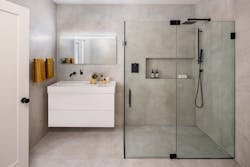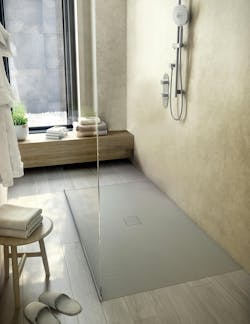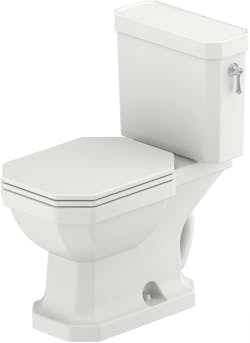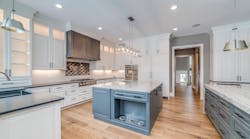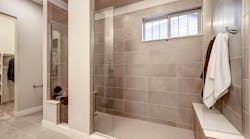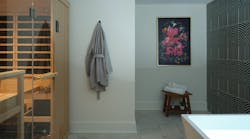This year marks 35 years since the Americans with Disabilities Act (ADA) helped reshape accessibility standards. While the ADA mainly applies to public and commercial spaces, many residential builders and designers have long adopted these guidelines, particularly as the population has aged.
These days, however, professionals are increasingly recognizing that, while compliance with ADA principles remains essential, the approach itself has limitations.
"Its framework, focused primarily on 'disability,' can unintentionally overlook those who do not identify as having a disability yet still face challenges navigating built environments," says Perrin Graham-Jackson, senior project designer at West End Interiors and chair elect for the American Society of Interior Design's Universal Design Committee.
This recognition has led to a broader philosophy of Universal Design, which Graham-Jackson describes as a more human-centered approach that considers all physical, sensory, and cognitive abilities.
"[Universal design] views health, age, and ability as spectrums and anticipates that everyone will experience limitations at some point in life," she explains. "The goal is to create environments inherently usable by all people, without adaptation or specialized solutions."
Below, we highlight a selection of products and some practical considerations for creating spaces that can help embrace this universal vision for the next 35 years, and beyond.
Walk-In or Curbless Showers
Bathrooms present some of the biggest accessibility challenges in the home, which is why curbless showers are often the first feature universal design advocates recommend. By eliminating the step-over barrier, these seamless entries create more navigable spaces for all abilities.
Products like MTI Baths' Delgada mineral composite shower base offers a zero-threshold, slip-resistant surface that can be recessed into the floor for a seamless shower zone. These one-piece bases simplify cleaning without grout lines to capture dirt, similar to large tile or slab walls. All models are low-profile and can be specified to accept glass enclosures on one, two, or three sides.
Infinity Drain’s barrier-free linear drain also makes curbless showers possible by efficiently directing water drainage without relying on a traditional curb to hold the water in.
In these showers, the floor must be laid with a subtle slope to direct water toward the drain. Fewer areas for water and dirt to collect means cleaning should be simpler too.
Infinity emphasizes the importance of keeping floor heights consistent between the shower, bathroom, and adjoining rooms.
Accessible Toilets
Under ADA guidelines, mounting heights matter: a toilet seat between 17 to 19 inches from the floor makes it easier for people with mobility challenges to sit and stand safely and independently.
Lever placement matters, too. Two of Duravit’s recent North American launches, the 1930 Series Two Piece Toilet and D-Neo PRO Series , offer the flexibility to install the flush handle on either side. This ensures the handle is positioned away from walls or obstructions that could hinder use for those with limited reach or mobility.
Plus, there’s a special coating baked into the ceramic that prevents dirt and limescale from taking hold, making residue run off more easily and staying cleaner, longer.
Low-Profile Refrigerators
In the kitchen, general aging-in-place guidelines set countertops at a 32-inch maximum height, a useful reference point for residential design.
True Residential’s Low Profile Collection of undercounter refrigerators, beverage centers, and wine cabinets are designed to fit within that height.
Each unit measures 31 7/8 inches tall (rather than the original 34 1/4" height) to meet the 32-inch regulation, allowing for installation under ADA-compliant countertops. The units are UL-rated for both indoors and outdoors, and use accessibility features like reversible hinges, drawer-style designs, and adjustable legs for flexible installation. The brand offers a wide variety of finishes and hardware options to suit diverse aesthetics.
Lever-Shaped Door Hardware
Under the ADA, door hardware must be operable with one hand, without tight grasping or twisting, and mounted between 34 and 48 inches above the floor. Lever-style handles, and U-shaped pulls are preferred for ease of use across a range of abilities.
Rejuvenation’s Bowman Brass Lever Exterior Door Tube Latch Set meets these criteria, combining a slim, modern design with straightforward operation. Its concealed fasteners and solid brass construction add substance without sacrificing accessibility. Integrated smart lock options like the Level Bolt provide keyless entry and remote control, further enhancing user convenience.
Sliding Door Systems
Sliding doors minimize space needed to otherwise open and close swinging doors. While the ADA doesn’t specifically require them, its standards for door width, accessible hardware, and ease of operation often make sliding systems a natural fit.
Rimadesio’s Sail system is one example. The double-sided sliding panels glide on smooth hardware with an integrated handle that requires just one hand, with no tight grasping or twisting. The glass and aluminum construction, available with walnut or oak veneers, offers customizable widths that exceed ADA’s 32-inch minimum clearance for comfortable wheelchair access. Three installation options—ceiling-mounted, built-in, or wall-fixed rails—maintain clean lines for a design-forward approach. The brand’s Air and Radius pivot doors also offer ADA-friendly dimensions and hardware.
What's great about all these examples is that they prove accessibility and great design aren’t mutually exclusive. They’re better together. CB
Now accepting entries for the 2026 Most Valuable Product Awards. Seeking Innovation in Residential Building Products. Enter Now →
About the Author
Pauline Hammerbeck
Pauline Hammerbeck is the editor of Custom Builder, the leading business media brand for custom builders and their architectural and design partners. She also serves as a senior editor for Pro Builder, where she directs products coverage and the brand's MVP Product Awards. With experience across the built environment - in architecture, real estate, retail, and design - Pauline brings a broad perspective to her work. Reach her at [email protected].
